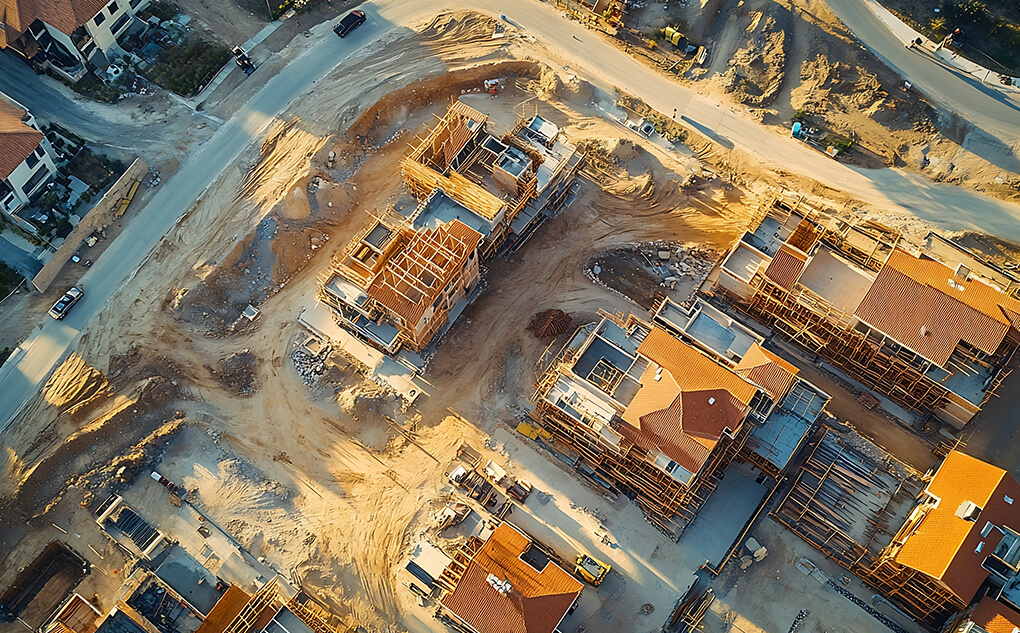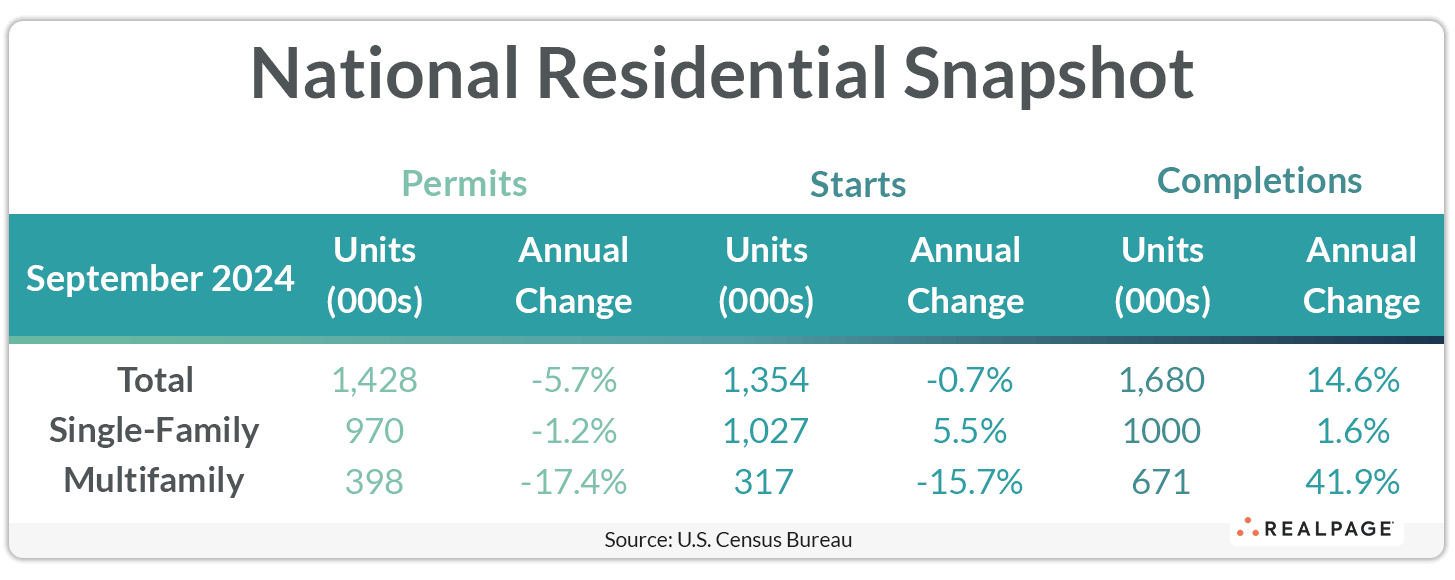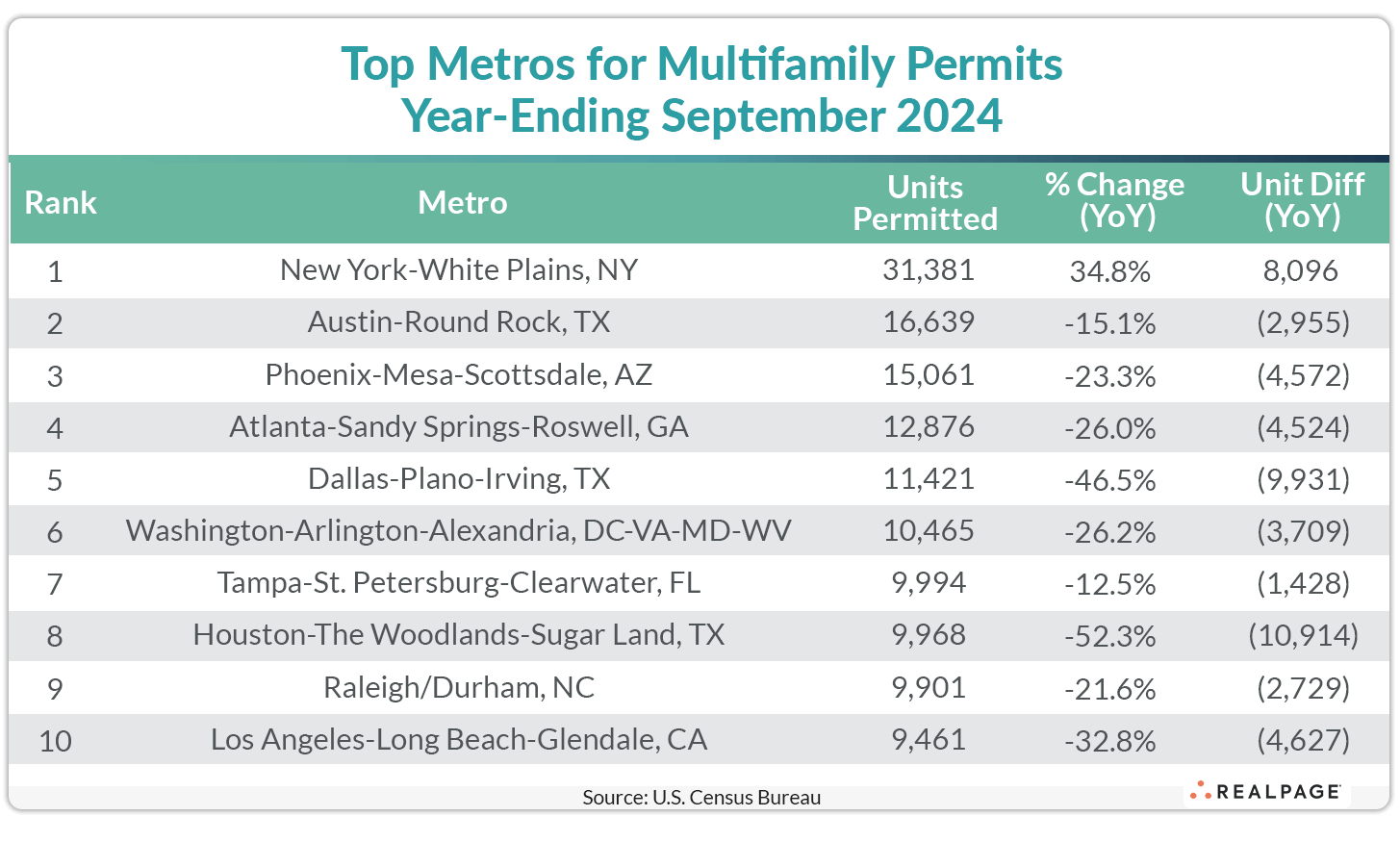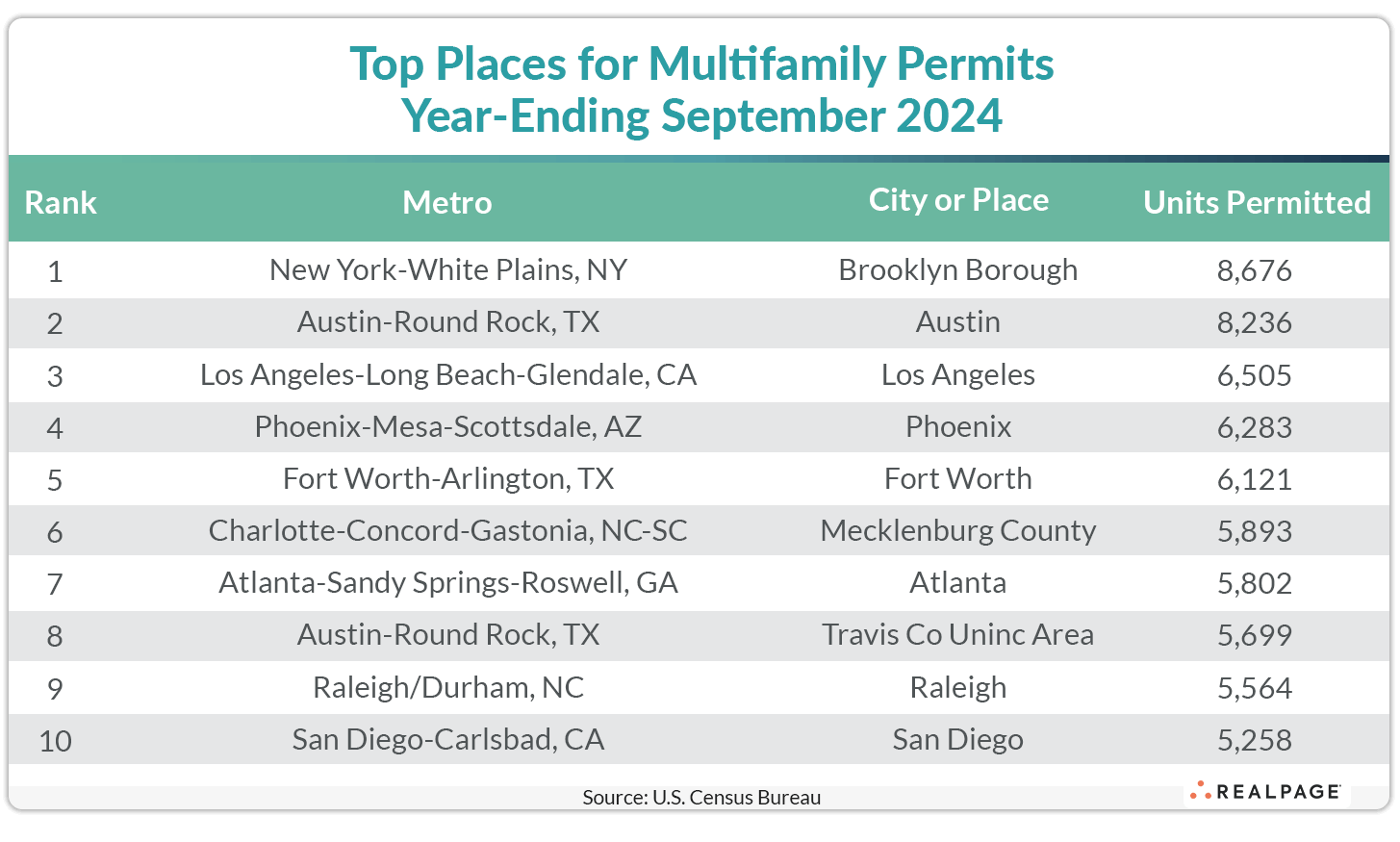Annualized multifamily starts peaked in 2022, and the current wave of apartment development has begun to slow. Multifamily starts have seen double-digit annual decreases in 13 of the past 16 months.
According to the latest report from the U.S. Census Bureau and the Department of Housing and Urban Development, annualized multifamily starts of 317,000 units were down 4.5% from August’s annual figure and down 15.7% from last September. Despite recent increases in the 30-year mortgage rate, annualized single-family starts were up 2.7% for the month and 5.5% for the year at 1.027 million homes.
However, the falling starts rate for multifamily units resulted in a 0.5% decrease in total residential starts from last month and a similar 0.7% decrease for the year to a rate of 1.354 million units.
Meanwhile, multifamily permitting fell 10.8% in September from August to 398,000 units, down 17.4% for the year. Single-family permitting ticked up 0.3% from last month to 970,000 units, but that was still down 1.2% from last September. Together with the small two-to-four-unit category, total permitting declined 2.9% from August to 1.428 million units and were down 5.7% year-over-year.
Multifamily completions dipped 8.7% from August to 671,000 units but are up almost 42% from last year. Single-family completions were down 2.7% for the month but up 1.6% for the year to one million units. The rate for multifamily units under construction fell 3.5% for the month and 16.8% for the year to 825,000 units. The number of single-family units under construction increased a slight 0.3% from August to 642,000 units but were down 4.5% from one year ago.
Compared to one year ago, the annual rate for multifamily permitting decreased in all four Census regions. The deepest decline in annualized multifamily permitting occurred in the West region (-26.7% to 94,000 units), while the Northeast region declined 19.7% to 50,000 units and the Midwest region was down 15.5% to 56,000 units. The more active South region was down 12.1% from one year ago with 198,000 units permitted. Compared to the previous month, permitting was down in all but the West region.
Annualized multifamily starts increased sharply in the small Northeast region (up 183% to 84,000 units), while starts were down in the West (-45.3% to 44,000 units), the South (-31.6% to 135,000 units) and in the Midwest (-21.3% to 56,000 units). Compared to August’s pace, starts were down in the West and South, up slightly in the Midwest and more than tripled in the Northeast.
Metro-Level Multifamily Permitting
All the top 10 markets from August’s list returned in September with the first five remaining in order.
New York remained the top multifamily market in the 12 months ending in September with 31,381 units permitted, up almost 35% from last year and up 4.2% from August. Austin returned at #2 with 16,639 units permitted, down about 15% from last year and down 5.2% from last month.
Phoenix remained in the #3 spot, permitting a total of 15,061 units for the year, down 23.3% from last September and 9.3% less than in August. Atlanta and Dallas remained in their #4 and #5 spots with 12,876 units permitted in Atlanta and 11,421 units for Dallas. Both were down 2% to 3% from August, but Dallas has slowed by almost 10,000 units from last year’s permitting pace.
Multifamily permitting also continues to slow in Houston with 11,601 units permitted to remain in the #6 spot, with 10,437 units less than last year but about 300 units more than August’s total. Washington, DC also remained in place at #7 with 10,984 units permitted through September, but that was down 5,512 units from last year’s pace.
Washington, DC and Tampa each moved up one spot to #6 and #7, dropping Houston three spots to #8 in September. DC permitted 10,465 units for the year, down 26.2% for the year and Tampa’s multifamily permit total was 9,994 units, down 12.5% from last September. Houston was edged by Tampa by only 26 units to total 9,968 units for the year, down 52.3% for the year and 14.1% below last month.
Returning at #9, Raleigh came close to Houston’s total with 9,901 units permitted, down 21.6% from last year but up 1.4% from August. Los Angeles also returned to its former spot at #10 with 9,461 multifamily units permitted for the year-ending September, down almost 33% for the year and 2.6% less than last month.
Of the top 10 multifamily permitting markets, all but New York decreased their annual totals from the year before and some were pretty significant declines. Houston had the deepest decrease in annual multifamily permitting of the top 10 markets (-10,914 units), followed closely by Dallas (-9,931 units), Los Angeles (-4,627 units), Phoenix (-4,572 units), Atlanta (-4,524 units), Washington, DC (-3,709 units), Austin (-2,955 units) Raleigh/Durham (-2,729 units) and Tampa (-1,428 units).
Other major non-top 10 markets with significant declines in annual permitting include Minneapolis/St. Paul (-6,505 units), San Antonio (-5,908 units), Jacksonville (-5,182 units), Riverside (-4,893 units), Miami (-4,370 units), Portland, OR (-3,766 units), Salt Lake City (-3,162 units) and Nashville (-3,041 units).
Other markets with significant year-over-year increases in annual multifamily permitting in the year-ending September were Fort Worth (+3,192 units), Omaha (+2,069 units), Ashville, NC (+1,945 units), Kansas City (+1,490 units), Oxnard (+1,343 units), Knoxville (+1,311 units) and Milwaukee (+1,079 units).
The annual total of multifamily permits issued in the top 10 metros – 137,167 – was about 21% less than the 140,593 issued in the previous 12 months and down 2.4% from last month. The total number of permits issued in the top 10 metros was almost equal to the number of permits issued for the #11 through #34 ranked metros.
Below the metro level, nine of last month’s top 10 permit-issuing places returned to this month’s list with only the first two remaining in the same place. The list of top individual permitting places (cities, towns, boroughs, and unincorporated counties) generally include the principal city of some of the most active metro areas.
The borough of Brooklyn returned to the #1 spot in September, permitting 8,676 units for the year followed by the city of Austin at the #2 position with 8,236 units permitted, close to its total in August. The cities of Los Angeles and Phoenix switched spots again at #3 and #4, with 6,505 units permitted in LA and 6,283 units permitted in Phoenix. Both cities’ permitting totals declined from August.
The city of Fort Worth moved up two spots to #5 with 6,121 units permitted, 326 units more than August’s total. Mecklenburg County (Charlotte) slipped one spot to #6 with 5,983 units permitted, down almost 500 units from last month. The city of Atlanta also moved up two spots to #7, permitting 5,802 units in the year-ending September, 662 units more than in August.
Unincorporated Travis County (Austin) fell two spots to #8 with 5,699 units permitted, down 10.5% or 601 units from their total last month. The city of Raleigh slipped one spot to #9 with a multifamily permit total of 5,564 units, down only 2% from August, while the city of San Diego moved into the #10 spot with 5,258 units permitted, up 3.2% for the month.
While Texas still leads all states with six of the top 20 individual permitting places on September’s list, New York takes four spots with four of NYC’s five boroughs accounted for. California and North Carolina each had two permitting places on the top 20 list. The cities of Dallas and Houston continue to move down the top 20 places list, while other southern cities like Raleigh, Atlanta and Nashville are moving up.











